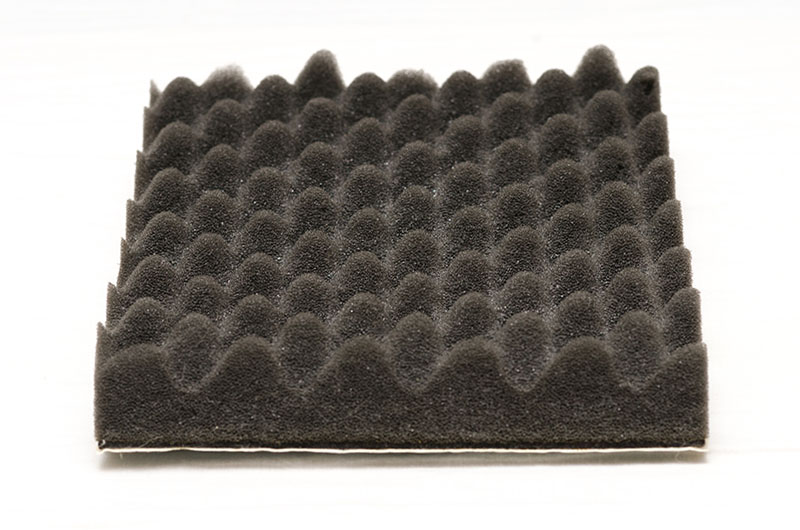任務Task
Make soundproof earphones to block out background noise so that you can listen to music with the earphones in a noisy place
隔音的基礎知識Background knowledge of soundproofing
隔音的基本原理是使用適當的物料來吸收或反射環境中的背景噪音。
一般來說,柔軟、具彈性和透氣的物料都是良好的聲音吸收體。例如圖1所示的吸音棉便具備上述特性。它主要在錄音室或工廠中作隔音用途。
The basic principle of soundproofing is using suitable materials to absorb or reflect background noise from the environment.
In general, soft, flexible, or porous materials are good sound absorbers. For example, Fig. 1 shows an acoustic foam which has these properties. It is commonly used for soundproofing in studios and industrial facilities.

圖1
Fig. 1
另一方面,較硬和密度較高的物料則多是良好的聲音反射體。馬路上的一些隔音屏障便由混凝土製成,如圖2所示。
On the other hand, dense and hard materials such as concrete are good sound reflectors. For example, some noise barriers on a road are made of concrete as shown in Fig. 2.

圖2
Fig. 2
老師會把全班分成數組,並為每組提供一個耳筒。試和你的組員合作進行公平測試,以找出哪種物料具備隔音效能,然後嘗試利用這種物料來製作能阻隔噪音的耳筒。Your teacher will divide the class into groups and give each group simple earphones. Collaborate with your group members to design a fair test to find out which material can be used to block out background noise. Then try to make soundproof earphones using the material.
第一部分—認清問題Part A—Identify the problems
1.
假設你是一個設計和製作耳筒的工程師。解釋為甚麼製作一個更能阻隔背景噪音的耳筒會較好。
1.
Suppose you are an engineer to design and make earphones. Why should it be better to make the earphones more soundproof to background noise?
第二部分—資料搜集Part B—Do research
2.
哪些物料在日常生活中常被用作阻隔噪音?它們有甚麼共同特點?
1.
Search some information about the principle of soundproofing and write it down briefly.
2.
Which kinds of materials are commonly used in daily life to block out noise? Are there any common properties of these materials?
第三部分—設計公平測試Part C—Design the fair test
1.
在網上搜尋資料,以設計一個實驗來測試不同物料的隔音效能。
2.
試簡單描述你會如何進行公平測試,並分辨測試中的各項變數。你亦可繪畫標註圖來顯示你的實驗裝置。
1.
Search information on the Internet and design a fair test to test the soundproofing ability of different materials.
2.
Briefly describe how you will perform the fair test and identify different variables of the test. You may also draw a labelled diagram to show your set-up.
第四部分—設計能阻隔噪音的耳筒Part D—Design soundproof earphones
1.
試想出能使耳筒更有效地阻隔噪音的方法。你可在網上搜尋資料,找出在噪音環境中工作的人(例如地盤工人,或在機場跑道附近工作的人)所佩戴的聽覺保護器的設計。
2.
在以下的空位繪畫你的設計,並在各部分加上標註。試簡單描述你會如何製作能阻隔噪音的耳筒。
1.
Think about different methods of making the earphones more soundproof to background noise. You can search the Internet for some existing design of ear protectors in different industries (such as for construction workers, or airport workers who work near runways).
2.
Draw your design below. Label all the parts. Also, briefly describe how you will make the soundproof earphones.
第五部分—進行公平測試和製作能阻隔噪音的耳筒Part E—Perform the fair test and make the soundproof earphones
- 收集公平測試所需的物料。
- 和組員合作進行公平測試。
- 選擇適當的物料來改良耳筒阻隔噪音的能力。
- 和組員製作能阻隔噪音的耳筒。
- 設計如何測試耳筒的隔音效能。
- Collect the materials needed in the fair test.
- Collaborate with your group members to perform the fair test.
- Decide which kind of material should be used in improving the soundproofing ability of the earphones.
- Collaborate with your group members to make the soundproof earphones.
- Design how to test the soundproofing ability of the earphones.
第六部分—傳達結果Part F—Communicate results
- 分享公平測試的結果,並在班上展示製成品。你也可播放你拍攝的短片,以顯示你的製作過程。
- Present your results and display your work to the class. You may also show a short video of your work procedure.
第七部分—評價和改良Part G—Evaluate and redesign
2.
你認為哪一組的設計是最好的?寫出他們的設計的兩個優點。
1.
Ask your teacher to evaluate your work using the following Grading Rubric:
2.
Which group’s design do you think is the best? Write TWO advantages of their design.
3.
What further modifications can you make to your earphones?
4.
Submit Student’s Worksheets to your teacher after the lesson.
附加資源Further resources
3D 打印3D printing
如果學校有3D打印機,你可以在我們的網站下載可供3D打印的模型。如果你會使用3D製圖軟件(例如
Blender),更可以設計和製作自己的3D打印模型。
If 3D printers are available at your school, you can download free models for 3D printing from our website. If you are familiar with 3D graphic tools (e.g.
Blender), you can also design your own 3D-printed models.